The Parents Guide to Kids Fighting: Why It Happens and How to Handle It
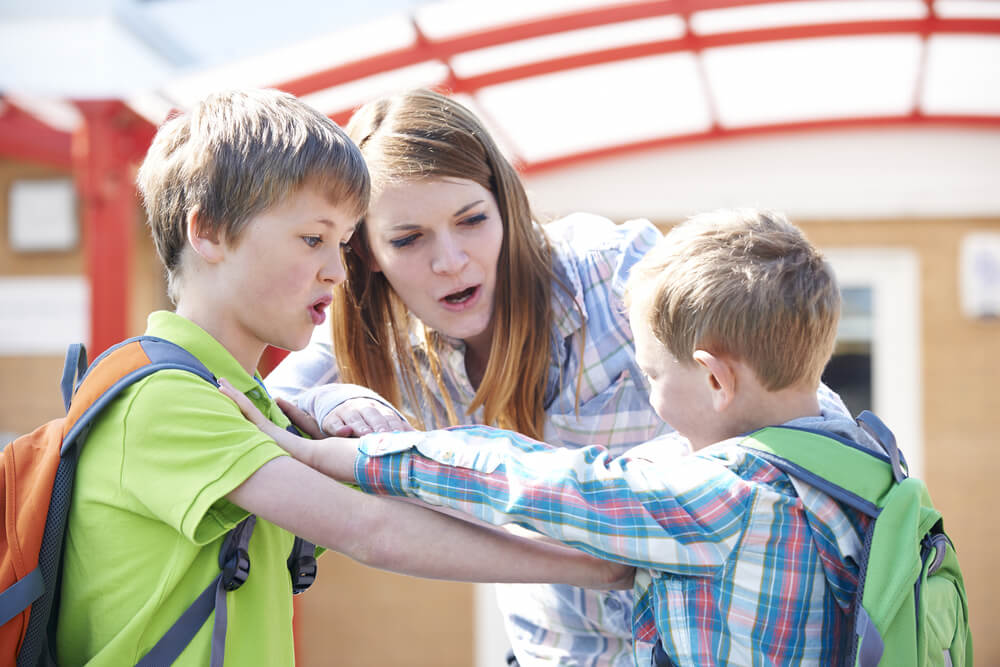
Are your kids fighting at school? Don’t feel like you’re the only parent struggling with this.
A lot of kids fight at some stage or another. There are many reasons for this, but regardless of the explanation, kids fighting often causes a lot of stress and tension for parents.
Read on to learn all about the reasons behind kids and siblings fighting, along with some tips and tricks on how you can handle it.
Contents:
- Children’s Fights: Why They Happen and What To Expect
- What Affects Children’s Fighting?
- How To Handle Fighting at School and at Home: Tools Parents Can Use Today
- FAQs
Children’s Fights: Why They Happen and What To Expect
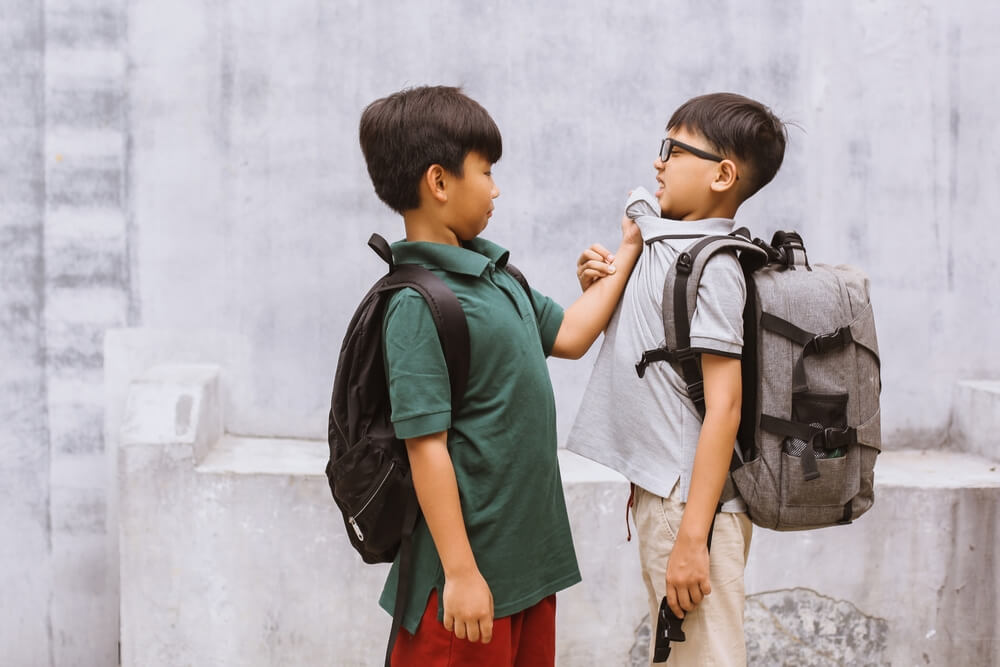
Gatot Adri/Shutterstock.com
Fights and arguing among children are very common. Just like with adults, kids sometimes don’t get along, disagree, or simply grow frustrated and tired with one another. However, where adults often have the maturity to talk things out or find other ways of conflict resolution, kids don’t have the same faculties and tend to launch directly into fights and aggression.
In many ways, conflict among schoolchildren is natural and normal. It’s not pleasant to look at or hear about, but the vast majority of kids will have some sort of fight or at least the odd disagreement with their siblings, classmates, or even best friends from time to time. That’s all part of the nature of growing up and learning about how to interact with other people.
In terms of the “Why?” behind children’s fights, there are lots of possible causes and explanations. Children might get angry with one another over things that may seem trivial or bizarre to adults. Or the reasoning may be more obvious – for example, a child may get into a fight with their bully if they’re sick of being picked on and called names.
Children may also fight over things like not sharing, feeling left out or alienated by certain groups, losing attention from their closest friends, or even if they just feel angry about something unrelated to the person they’re actually fighting, like an issue at home or something going on in their family life.
In short, there are hundreds or even thousands of potential explanations, but they all boil down to the same basic concept: kids most often fight when they’re angry, upset, or have other negative emotions that they don’t fully control or understand. This makes them lash out, which can lead to shouting and hitting other kids.
Why Do Siblings Fight?
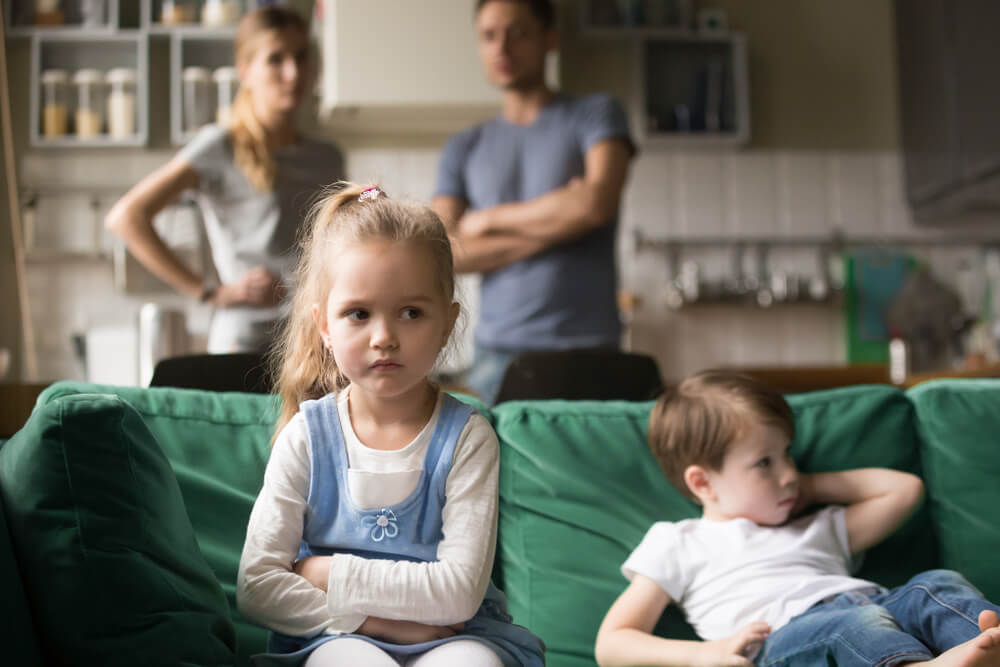
fizkes/Shutterstock.com
Siblings fighting is a really common issue that so many families have to deal with. Just like kids fighting in general, sibling fighting is pretty normal and natural. However, the reasons behind it can be a little different when compared to general kids fighting in the classroom or on the playground, for example.
Аccording to research published by the American Psychological Association (APA), approximately 80% of children experience some form of sibling conflict during childhood. Moreover, a study conducted by the National Institute of Child Health and Human Development (NICHD) found that sibling aggression, including physical fighting, occurs in about one-third of sibling relationships.
A lot of times, siblings fight because they live in close proximity together, spend lots of time together, and naturally grow frustrated with one another now and then. They might also be annoyed or upset for other reasons, but take it out on their siblings purely due to the fact that they’re an “easy” target.
Siblings may also fight, in part, because of the way their parents treat them. One sibling might be angry if they feel like their brother or sister receives preferential treatment or seems to be favored by their mom or dad, for example. Or, if the parents are very busy and don’t spend much time with the kids, that can also lead to resentment and negative emotions building up.
Here’s a list of specific points summarizing the reasons why siblings fight:
- Competition for attention or resources, such as toys or parental approval.
- Differences in personalities, interests, or temperaments (we all know the troubled youth type—they’re quicker to lash out than their peers, simply due to shorter tempers or higher aggression levels).
- Power struggles and attempts to assert dominance or control.
- Mimicking behavior observed in adults or media.
- Unresolved conflicts or past grievances.
- Need for independence and boundaries within the family dynamic.
- Developmental stages and changes in age-related roles and responsibilities.
- Lack of effective communication skills or conflict resolution strategies.
- Limited space or privacy in shared living environments.
- Normal developmental behaviors such as testing boundaries and asserting autonomy.
Why Do Kids Fight at School?
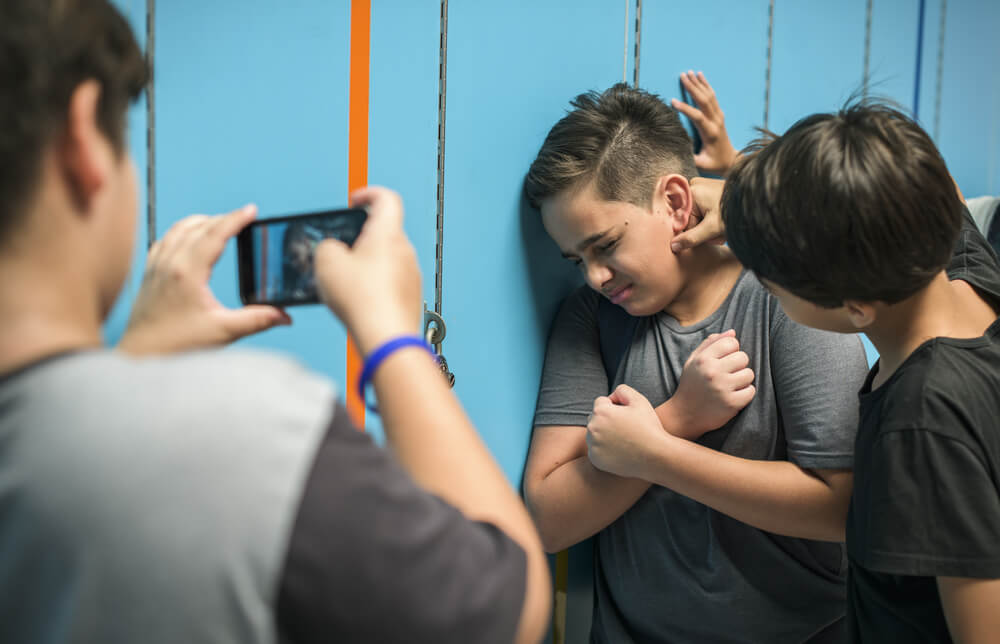
Rawpixel.com/Shutterstock.com
At school, there are also many reasons why kids might fight. Sometimes, it’s plain and simple bullying. One child may decide to pick on someone else for whatever reason. It could be the way they look, part of their personality, their ethnic background, the fact that they don’t fit in as well with everyone else, or something different.
When it comes to fights at school, data from the National Center for Education Statistics (NCES) indicates that incidents of physical altercations among students have decreased in recent years. However, bullying remains a prevalent issue, with surveys reporting that around 20% of students in the United States have experienced bullying, either as a victim or as a perpetrator.
There’s lots of bullying going on in schools all over the globe, and it can be a difficult issue to identify and resolve. Some kids become violent and aggressive bullies and will fight almost any other child, regardless of what they have or haven’t done, purely as a way to let out their anger and frustration—which may be caused by their parents or at-home issues.
Kids might also fight at school due to disagreements and arguments that escalate into aggressive encounters. They might begin by arguing over something mundane, like one child skipping the cafeteria queue at lunch or a rumor they overheard in the schoolyard. Then, over time, those little arguments may build up into full-on fights.
Here’s a list of specific points summarizing the reasons why kids fight at school:
- Conflict over belongings or possessions, such as toys, gadgets, or school supplies.
- Differences in opinions, beliefs, or values lead to disagreements.
- Peer pressure and influence from friends or social groups.
- Misunderstandings or miscommunication between students.
- Bullying or harassment from peers, including verbal, physical, or cyberbullying.
- Competition for academic achievements, recognition, or leadership roles.
- Provocation or teasing from other students.
- Lack of conflict resolution skills or emotional regulation techniques.
- Social or cultural differences lead to misunderstandings or clashes.
- Seeking attention or recognition from peers or authority figures.
- Stress, anxiety, or frustration over seemingly unrelated external circumstances, like school exams or any other school concept. The divorce concept can be especially challenging for young school children to process and lead to additional stress that causes fighting.
What Affects Children’s Fighting?

Prostock-studio/Shutterstock.com
There are a lot of different factors that may impact how likely kids are to fight and how the fights actually play out. Here are some key examples.
Temperament
Naturally, temperament is key when considering how likely anyone is to get involved in a fight—either starting it themselves or engaging with it if someone else tries to fight them. Some people—including children—are naturally more prone to aggression and confrontation than others and will therefore be more likely to have fights.
Parents and teachers therefore need to be particularly cautious around kids who tend to lose their tempers quickly or those who tend to become aggressive and angry because of relatively minor triggers. Meanwhile, kids who are more shy, introverted, and anxious are generally less likely to seek out or engage in physical conflict.
Environment
The environment can also impact kids fighting. It has a direct influence on their mood, emotions, and mental state. For example, in a home where violent behavior and aggression appear to be commonplace and normal, it’s much more likely for kids to emulate the behavior they see around them and be aggressive too.
Meanwhile, in calm, safe, and pleasant surroundings, children will typically be less likely to get involved in conflict and aggression. This is why teachers and parents have a part to play in fostering pleasant and comfortable environments where kids feel they can talk out their differences or get help from adults, rather than resorting to violence.
Age and Skills
Age and physical abilities will also impact the likelihood of fights and the potential dangers of those fights. Naturally, when kids get older and physically stronger, they can do more damage to one another. Two 16-year-olds fighting can really hurt one another, for example. Younger kids are less likely to do serious harm, but that doesn’t mean they can’t still injure one another.
Age also has an impact on mental state and a child’s ability to reason and control their emotions. Very young kids may be more prone to lashing out with aggression if they feel angry, as they don’t yet understand how to talk through their problems and express their emotions in safer and calmer ways.
How To Handle Fighting at School and at Home: Tools Parents Can Use Today
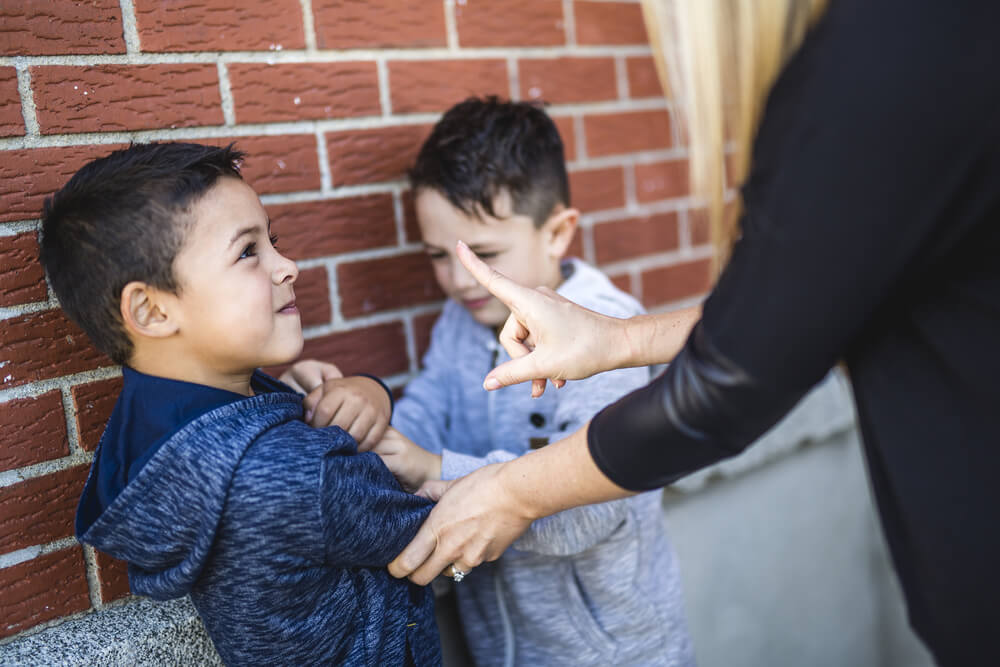
Lopolo/Shutterstock.com
Next, let’s look at some sensible tips and tricks that parents can keep in mind and utilize to help them manage fights if and when they break out, both in the home or at school.
Sibling Fights/Fights at Home — How To Deal
- Keep Calm: First, calmness is key when it comes to responding to siblings fighting. If you get angry or emotional, like the children, you’re more likely to make the problem worse. Breathe and keep a level head as you try to calm the situation down. “I understand that you’re upset, but let’s talk about what happened. Can you tell me what happened from your point of view?”
- Listen to Both Sides: Communication is always important in these kinds of situations. Once you’ve calmed and separated the fighting children, listen to their sides of the story and find out how and why the fight began. “It’s important for both of you to share your side of the story. Please take your time to explain what happened.”
- Set Rules and Guidelines: In the home, parents should establish clear rules that kids need to follow, which should include no fighting or physical aggression. Kids should also be aware of the consequences (punishments) for breaking those rules. Be consistent with how you discipline your school children of any age. “In our family, we use our words to solve problems, not our fists. If you choose to hit, there will be consequences, like losing screen time or privileges.”
- Set an Example: Kids of all ages look at their parents as role models. It’s up to you to set the standard and show children how to behave. If you’re prone to getting aggressive and violent, kids may copy that. Show them the right way to resolve conflicts. “I understand that we have different opinions, but let’s find a compromise that works for both of us. How about we take turns choosing what to watch on TV?”
- Encourage Empathy: Talk to children about the importance of empathy. Ask them to put themselves in other people’s shoes and think about how they might be feeling and how they might suffer and be scared of fighting. “How would you feel if someone treated you the way you treated your sibling/classmate? It’s important to think about how our actions affect others.”
- Be Attentive: Often, kids will show signs of anger or being upset before lashing out and starting a fight. Be attentive to them and talk to them if it feels like something is wrong. Again, communication is crucial here. “I can tell something is bothering you. Would you like to talk about it? I’m here to listen and help.”
- Seek Professional Help if Needed: If sibling fighting is a recurring or serious issue in your household, you may need expert help to resolve it. Counselors and therapists may be able to help you get to the bottom of the problem.
Fights at School

Findmykids app
- Communicate: Often, parents will only hear about fights at school after they’ve occurred, and usually through teachers or other parents. Communicate with your kids to get the full story and understand how and why a fight occurred. “I want to understand why the fight occurred. Can you walk me through what happened from your perspective?”
- Understand: It can be tempting to get angry or jump to conclusions if you hear your child is involved in a fight. But it’s important to understand their side of the story and acknowledge their emotions, even if you don’t necessarily agree with them. “It’s important for me to understand how you’re feeling and why this happened. Let’s talk about it together.”
- Speak with School Staff: At school, teachers are responsible for the safety of children, so you’ll most likely want to speak with them to find out what they’re going to do to prevent future fights (and how you can help). Work with the team of educators at your child’s school to address patterns forming at school that threaten certainty around school safety. “I’ll schedule a meeting with the school staff to address the situation and see how we can support you better.”
- Teach Positive Conflict Resolution: Use your own wisdom and experience to guide your children. Teach them ways they can deal with aggression from others or resolve arguments and disputes, rather than escalate them into full-blown fights. “Let’s talk about how you could have handled the situation differently. What are some ways you could resolve conflicts peacefully next time?”
- Use Apps and Tech Tools: Apps like Findmykids can help you keep track of your children and ensure they’re not getting into dangerous locations. Findmykids even lets you listen in on children on-demand and check up on them if you’re worried.
- Positive Reinforcement: Positive reinforcement—acknowledging and rewarding children when they behave well—can be a valuable method in teaching them not to fight and instead to seek peaceful and calm resolutions. “I’m proud of you for handling that situation calmly. That’s exactly how we should handle conflicts.”
Keep your kids safe and connected with the Findmykids app. Download the app now to effortlessly track their location, set safe zones, and receive instant alerts. Gain peace of mind knowing you can always stay connected, wherever they may be.
Specific Steps for Those Who Witness a Fight in Progress and Need to Intervene Immediately
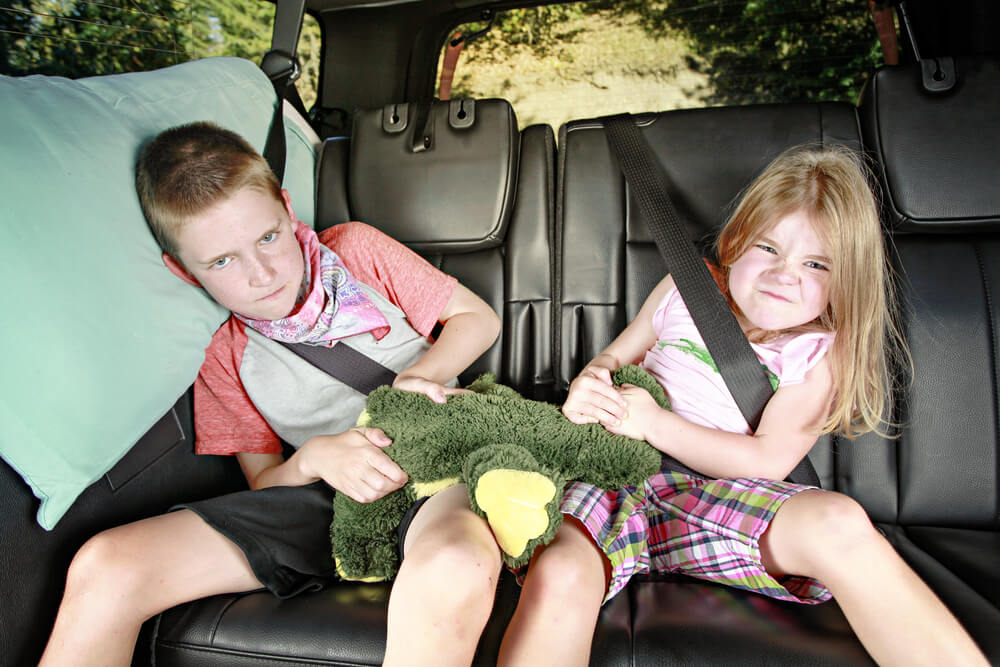
Collin Quinn Lomax/Shutterstock.com
- Quickly evaluate the safety of the environment and the severity of the fight. Look for any potential weapons or objects that could cause harm.
- If the fight is serious or you feel unable to handle it alone, call for help from other adults nearby, such as teachers, security personnel, or other parents.
- Approach the fighting children calmly but assertively. Use a steady and confident tone of voice to grab their attention without escalating the situation further.
- If the fight involves physical aggression, intervene immediately to physically separate the children. Use a non-threatening but firm grip to guide them apart and create space between them.
- Once the children are separated, give clear and concise instructions to help them understand what needs to happen next. Use simple commands like “Stop,” “Take a breath,” or “Listen to me.”
- Check for any injuries or signs of distress and provide assistance as needed. Attend to any physical injuries and offer comfort and reassurance to the children involved.
- Redirect the children’s attention away from the conflict by engaging them in a different activity or asking them to focus on something positive. This can help diffuse tension and calm emotions.
- Encourage the children to talk about what happened and express their feelings in a calm and respectful manner. Use active listening techniques to show that you are genuinely interested in understanding their perspective. (Examples of active listening techniques: 1. Mirroring—Repeat back what the child says to show understanding and encourage further expression; 2. Summarizing—Condense the child’s message into key points to demonstrate comprehension and provide validation.)
- After the immediate situation has been resolved, follow up with the children to ensure they are okay and offer ongoing support if needed. Discuss strategies for preventing future conflicts and encourage open communication moving forward.
By following these steps, you can effectively intervene in a fight as it’s happening and help de-escalate the situation while ensuring the safety and well-being of the children involved.
Summing Up: Dealing with Kids Fighting
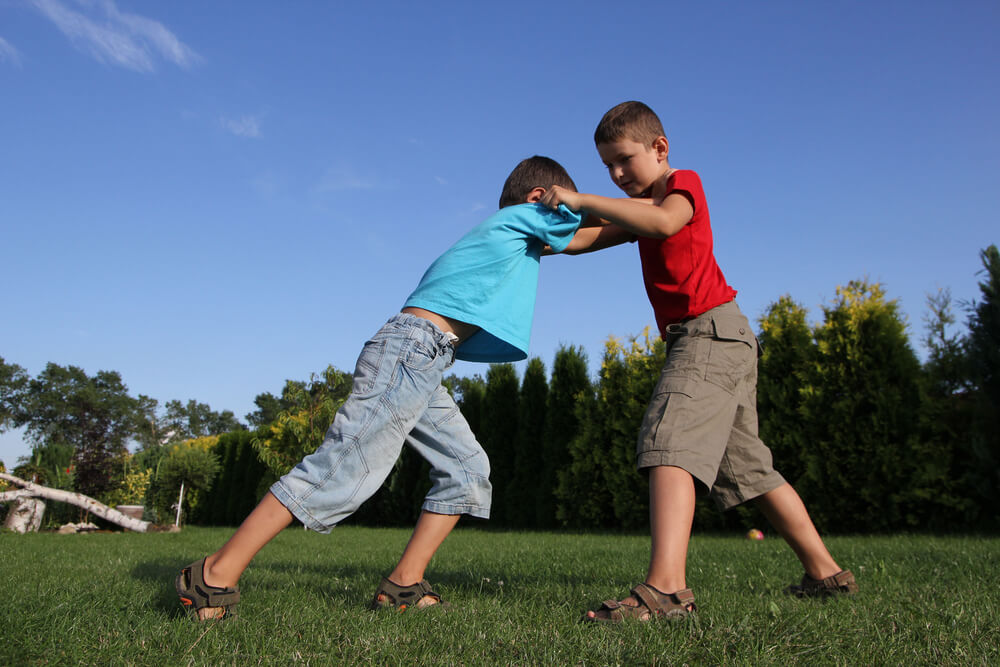
greenland/Shutterstock.com
Overall, there’s no doubt that kids fighting can trigger a lot of stress and fright for parents, teachers, and guardians. It’s never nice to see kids fighting or hear that your child has been involved in a fight. Unfortunately, this is something that a lot of parents will still have to go through at some time or another.
But, as this guide has shown, there are plenty of methods at your disposal to mitigate the risks and dangers of kids fighting. Communication is key, along with using technological tools—like the Findmykids app—to help keep track of your children and prevent them from getting into dangerous situations.
Keep these tips and tricks in mind to help keep your kids safe, and be sure to share this guide around. That way, other parents will also be able to get help with their kids or siblings fighting.
FAQs

Inside Creative House/Shutterstock.com
What do you do when your kids are fighting?
Ideally, the first focus should be to try to separate them as soon as possible. As long as it’s safe to do so, try to put yourself between the children and get them apart. Remain calm to the best of your abilities, and try to calm down your children, too, through some simple exercises like breathing or counting to 10. From there, you can discuss with them how the fight began.
How to handle kids fighting at school?
To handle kids fighting at school, first de-escalate the situation by calmly separating the students and staying composed to prevent further escalation. Once they have cooled down, assess the severity of the incident and involve another teacher or administrator if safety is at risk.
Afterward, talk to the child to understand their perspective, communicate with the school to get full context, and make clear that physical aggression is unacceptable. Long-term support includes teaching conflict-resolution skills, encouraging empathy, reinforcing positive behavior, and addressing underlying emotional triggers.
What to do with kids who won’t stop fighting?
There are many long-term teaching techniques you can try to encourage children or siblings to stop fighting. Often, communication is key. You have to understand why the fights happen and why one or more children feel such anger or strong emotions. Set rules and boundaries to help kids play and interact in safe ways, and supervise as needed to prevent fights from breaking out.
How much sibling fighting is normal?
Sibling rivalries and siblings fighting are very common phenomena, encountered by the majority of families. It’s natural and normal for brothers and sisters to get annoyed with one another and argue or clash from time to time. However, if the issue is persistent, recurring, and results in serious issues, like physical fights, parents will need to take steps to solve the issue.
Are parents responsible for sibling rivalry?
Parents’ actions can absolutely have an impact on sibling rivalries and make them worse, especially if children feel like one sibling is treated differently or favored over the other(s). It’s important for parents to spend quality time with their kids and treat them in a balanced way to reduce the risk of rivalries and siblings fighting.
Is it normal for kids to fight at school?
Kids—whether they’re elementary school girls and boys or older students—are navigating emotions, relationships, and boundaries. A high school student, in particular, is most likely to engage in fights on school property. Though not normal, fighting is not unusual.
What happens if my child gets in a fight at school?
If your child is involved in a fight on school property, their teacher at school and administration will likely step in to address the situation. Many schools have clear protocols involving communication with parents, discussions with the children involved, and sometimes even disciplinary actions.
Are school fights considered assault?
A physical altercation during school hours can sometimes escalate into a legal matter. Depending on the severity of the situation and the ages involved, fights could potentially be classified as assault, especially if someone is seriously hurt. However, schools often try to manage these incidents within the educational environment, keeping it focused on learning and restorative practices.
The picture on the front page: SpeedKingz/Shutterstock.com
Проверьте электронный ящик



















